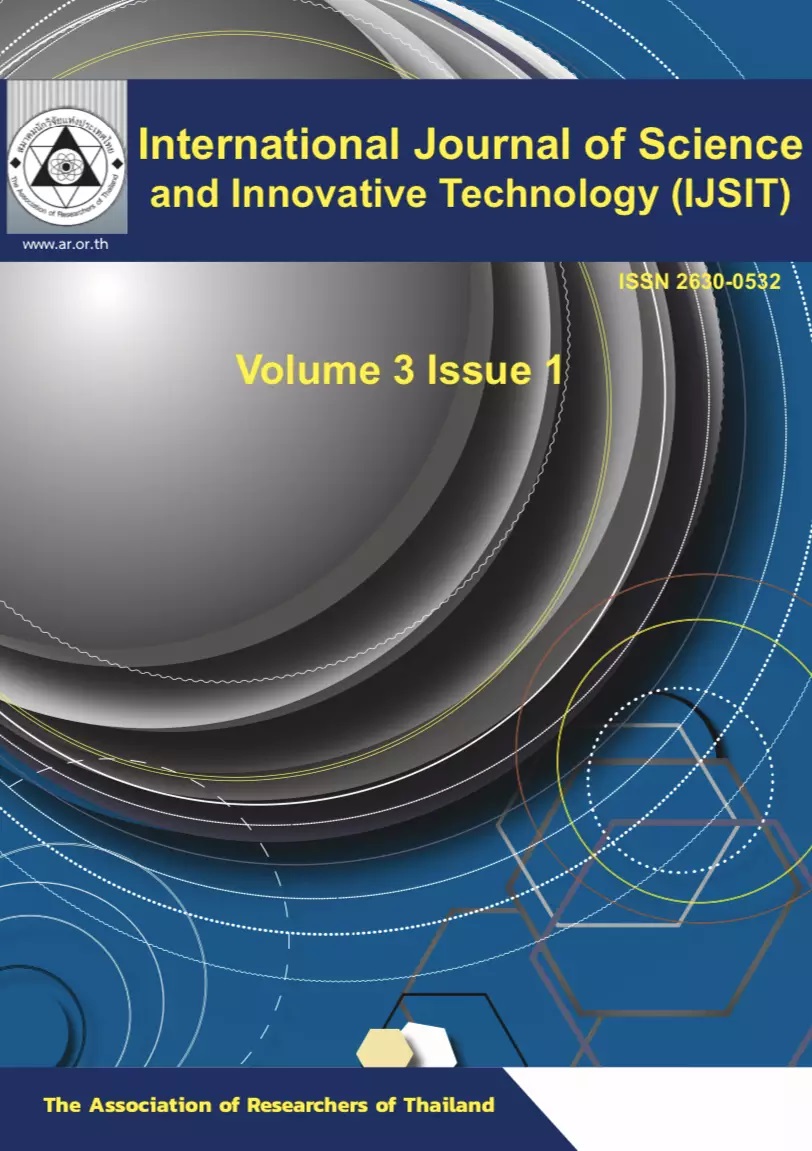Visible-Light Photocatalysis with WO3/TiO2 Nanocomposite Fiber Sponges Prepared via Solution Blow-Spinning Process
Main Article Content
Abstract
Three-dimensional nanocomposite fiber sponges consisting of tungsten trioxide (WO3) and titanium dioxide (TiO2) as visible-light photocatalysts were successfully prepared by solution blow-spinning process in combination with a calcination process (450 °C). The precursor solution of tungstic acid (H2WO4)/tetrabutyl titanate (Ti(OBu)4)/polyvinyl pyrrolidone (PVP) with various molar percentage ratios of tungsten to Ti (i.e., 0.5, 1.0, 3.0, and 5.0) in 75/25 w/w mixture of ethanol and acetic acid were prepared and blown-spun. Smooth fiber morphologies and average fiber diameters in a range of 480 nm to 645 nm before calcination and 351 nm to 479 nm after calcination were observed by a scanning electron microscope (SEM). The presence of WO3 within the nanocomposite fiber sponges was found by using X-ray diffractometer (XRD). The photocatalytic properties of the WO3/TiO2 nanocomposite fiber sponges were investigated by photocatalytic degradation of methylene blue solution under both UV- and visible-light radiation. Results showed that the WO3/TiO2 nanocomposite fiber sponges at molar percentage ratios of 5.0 exhibited the highest activity under both UV- and visible-light radiation.
Article Details
References
[2] Zhang, X., Fujishima, A., Jin, M., Emeline, A.V., & Murakami, T. (2006) Double-layered TiO2−SiO2 nanostructured films with self-cleaning and antireflective properties. The Journal of Physical Chemistry B, 110, 25142–25148.
[3] Ye, L., Pelton, R., Brook, M.A., Filipe, C.D.M., Wang, H.F., Brovko, L., & Griffiths, M. (2013) Targeted disinfection of E. coli via bioconjugation to photoreactive TiO2. Bioconjugate Chemistry, 24, 448–455.
[4] Luevano-Hipolito, E., Martínez-de la Cruz, A., Lopez-Cuellar, E., Yu, Q.L., & Brouwers, H.J.H. (2014) Synthesis, characterization and photocatalytic activity of WO3/TiO2 for NO removal under UV and visible light irradiation. Materials Chemistry and Physics, 148, 208–213.
[5] Elahifard, M.R., Rahimnejad, S., Haghighi, S., & Gholami, M.R. (2007) Apatite-coatedAg/AgBr/TiO2 visible-light photocatalyst for destruction of bacteria. Journal of American Chemical Society, 129, 9552–9553.
[6] Wang, X.P., & Lim, T.T. (2013) Highly efficient and stable Ag-AgBr/TiO2 composites for destruction of Escherichia coli under visible light irradiation. Water research, 47, 4148-4158.
[7] Zeng, Y., Wu, W., Soowohn, L., & Gao, J.H. (2007) Photocatalytic performance of plasma sprayed Pt-modified TiO2 coatings under visible light irradiation. Catalalysis Communications, 8, 906–912.
[8] Ismail, A.A., & Bahnemann, D.W. (2011) Mesostructured Pt/TiO2 Nanocomposites as highly active photocatalysts for the photooxidation of dichloroacetic acid. The Journal of Physical Chemistry C, 115, 5784–5791.
[9] Hayden, S.C., Allam, N.K., & El-Sayed, M.A. (2010) TiO2 nanotube/CdS hybrid electrodes:extraordinary enhancement in the inactivation of Escherichia coli. Journal of American Chemical Society,132, 14406–14408.
[10] Linsebigler, A.L., Lu, G., & Yates, J.T. (1995) Photocatalysis on TiO2 surfaces: principles, mechanisms, and selected results, Chemical Reviews, 95, 735-758.
[11] Laursen, A., Kegnas, S., Dahl, S., & Chorkendorff, I. (2012) Molybdenum sulfides-efficient and viable materials for electro- and photoelectrocatalytic hydrogen evolution, Energy & Environmental Science, 5, 5577–5591.
[12] Kment, S., Riboni, F., Pausova, S., Wang, L., Wang, L., Han, H., Hubicka, Z., Krysa, J., Schnuki, P., & Zboril, R. (2017) Photoanodes based on TiO2 and a-Fe2O3 for solar water splitting-superior role of 1D nanoarchitectures and of combined heterostructures, Chemical Society Reviews, 46, 3716–3769.
[13] Yadav, M., Yadav, A., Fernandes, R., Popat, Y., Orlandi, M., Dashora, A., Kothari, D.C., Miotello, A., Ahuja, B.L., & Patel, N. (2017) Tungsten-doped TiO2/reduced Graphene Oxide nano-composite photocatalyst for degradation of phenol: A system to reduce surface and bulk electron-hole recombination. Journal of Environmental Management, 203, 364-374.
[14] Mugunthan, E., Saidutta, M.B., & Jagadeeshbabu, P.E. (2018) Visible light assisted photocatalytic degradation of diclofenac using TiO2-WO3 mixed oxide catalysts. Environmental, Nanotechnology & Monitoring Management, 10, 322-330.
[15] Ofori, A.O., Sheikh, F.A., Appiah-Ntiamoah, R., Yang, X., & Kim, H. (2015) A Simple Method of Electrospun Tungsten Trioxide Nanofibers with Enhanced Visible-Light Photocatalytic Activity. Nano-Micro Letters, 7, 291–297.
[16] Doshi, J., & Reneker, D. H. (1995) Electrospinning process and applications of electrospun fibers. Journal of Electrostatics, 35, 151–60.
[17] Khil, M. S., Cha, D. I., Kim, H. Y., Kim, I. S., & Bhattarai, N. (2003) Electrospun nanofibrous polyurethane membrane as wound dressing. Journal of Biomedical Materials Research Part B: Applied Biomaterials, 67, 675–679.
[18] Chen, Z., Zhao, J., Yang, X., Ye, Q., Huang, K., Hou, C., Zhao, Z., You, J., & Li, Y. (2016) Fabrication of TiO2/WO3 composite nanofibers by electrospinning and photocatalystic performance of the resultant fabrics. Industrial & Engineering Chemistry Research, 55, 80-85.
[19] Chakornpradit, P., Phiriyawirut, M., & Vissanu Meeyoo, V. (2017) Preparation of TiO2/WO3 Composite Nanofibers by Electrospinning. Key Engineering Materials, 751, 296-301.
[20] Szilagyi, I. M., Santala, E., Heikkilä, M., Pore, V., Kemell, M., Nikitin, T., Teucher, G., Firkala, T., Khriachtchev, L., Räsänen, M., Ritala, M., & Leskelä, M. (2013) Photocatalytic Properties of WO3/TiO2 core/shell nanofibers prepared by electrospinning and atomic layer deposition. Chemical Vapor Deposition, 19, 149-155.
[21] Wang, H., Zhang, X., Wang, N., Li, Y., Feng, X., Huang, Y., Zhao, C., Liu, Z., Fang, M., Ou, G., Gao, H., Li, X., & Wu, H. (2017) Ultralight, scalable, and high-temperature–resilient ceramic nanofiber sponges. Science Advances, 3, 1–9.
[22] Ke, J., Zhou, H., Liu, J., Duan, X., Zhang, H., Liu, S., & Wang, S. (2018) Crystal transformation of 2D tungstic acid H2WO4 to WO3 for enhanced photocatalytic water oxidation. Journal of Colloid and Interface Science, 514, 576–583.


